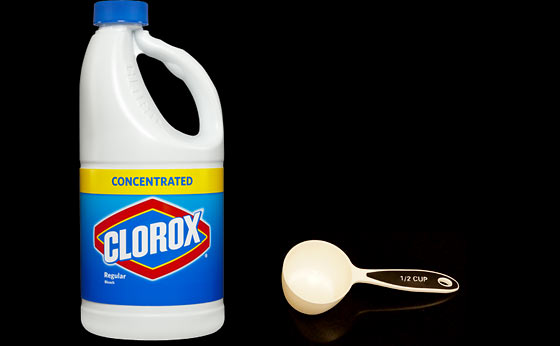Bleach Water Ratio For Disinfecting | Make Your Own Disinfectant
by Ken Jorgustin | Updated Mar 15, 2020 | HEALTH | 9 comments

I have updated the bleach water ratio for making your own disinfectant. I’m including the bleach disinfectant ratio for a Pint (2 cups), convenient for a spray bottle.
Bleach is one of the most widely available and affordable disinfectants on earth. Clorox® brand liquid bleach was introduced in 1913 and has played a critical role in helping to protect public health by killing germs that cause illness.
(Disinfectant Bleach Water Ratio Listed Below)
– Non food surfaces
– Food contact surfaces
Bleach is commonly mixed with water for use as a disinfectant to kill germs that can make people sick. This includes MRSA, Staph, and Norovirus (among many others!).
Germs and viruses can thrive in the kitchen, bathroom, baby’s room, laundry room, especially around toilets, sinks, faucets and bathtubs.
The World Health Organization (WHO) and the Centers for Disease Control and Prevention (CDC) – recommend the use of bleach for controlling the spread of pathogens that can cause infections and other health threats.
Recommended bleach disinfectant ratio mixed with water for non-food surfaces and food contact surfaces:
Bleach Water Ratio For Disinfectant (Non-Food Surfaces)
(NON-FOOD SURFACES)
– 2500 ppm chlorine mixture
For cleaning, sanitizing, and disinfecting surfaces such as bathtubs, sinks, faucets, tile, plastic toys, potty chairs, high chairs, changing tables, floors, appliances, countertops, garbage cans, walls, light switches, etc..
Pre-wash surface with detergent and water, then apply the sanitizing solution of bleach and water. Allow solution to contact surface for at least 5 minutes for optimum effectiveness. Afterward, rinse and-or air dry.
(Informational sources listed below)
(numbers are rounded)
BLEACH WITH 8.25% SODIUM HYPOCHLORITE CONCENTRATION:
Dilution bleach to water ratio of 1:30
1/2 cup Clorox® Regular-Bleach / GALLON water
3-1/4 teaspoons Clorox® Regular-Bleach per Pint (2 cups) of water
(HEAVY DUTY Spray Bottle (1.5 Pints) on amzn)
BLEACH WITH 6% SODIUM HYPOCHLORITE CONCENTRATION:
Dilution bleach to water ratio of 1:22
3/4 cup Clorox® Regular-Bleach / GALLON water
4-1/3 teaspoons Clorox® Regular-Bleach per Pint (2 cups) of water
Bleach Water Ratio For Disinfectant (Food Contact Surfaces)
(FOOD CONTACT SURFACES)
– 200 ppm chlorine mixture
For cleaning food handling equipment and food contact surfaces such as plastic cutting boards*, stainless cutlery, dishes, glassware, pots and pans, stainless utensils, pet bowls, teething rings,
Pre-wash surface with detergent and water. Then soak with the sanitizing solution of bleach and water. Allow solution to contact surface for at least 2 minutes for optimum effectiveness. Drain and air dry.
(Informational sources listed below)
(numbers are rounded)
BLEACH WITH 8.25% SODIUM HYPOCHLORITE CONCENTRATION:
Dilution bleach to water ratio of 1:392
2 teaspoons Clorox® Regular-Bleach / GALLON water
1/4 teaspoon Clorox® Regular-Bleach per Pint (2 cups) of water
BLEACH WITH 6% SODIUM HYPOCHLORITE CONCENTRATION:
Dilution bleach to water ratio of 1:285
2-5/8 teaspoons Clorox® Regular-Bleach / GALLON water
1/3 teaspoon Clorox® Regular-Bleach per Pint (2 cups) of water
I have a pair of these for when mixing larger batches of bleach (in a gallon bucket for example). It’s just a good thing to have a pair in general:
HEAVY DUTY PVC CHEMICAL GLOVES (Wells Lamont)
(view on amzn)
NOTE: This is NOT (NOT!) the formula for drinking water purification. Rather it is much stronger for disinfecting surfaces.
For drinking water purification, read the following articles:
Make Drinking Water Safe With Bleach
Bleach – Water Ratio For Drinking Water Purification
CAUTION: Do not mix Clorox® Regular-Bleach with other household chemicals. Toxic fumes could result.
TIP: Bleach formula breaks down after awhile. For health care, day care, it is commonly recommended to make new formula in 24 hours.
NOTE: Bleach solutions may discolor fabrics (your clothes, carpets, etc..).
For disinfecting Ebola virus, read: “Ebola Virus Disinfection With Bleach“
UPDATE: Clorox has adjusted their concentration blend (sodium hypochlorite) over the years. They’ve gone from 6%, up to 8.25%, and now they’re back to 6%. Look for the active ingredient on the label which will reveal which sodium hypochlorite concentration is being used. I’ve shown the formulas for each, above.
What is the difference between cleaning and disinfecting?
Cleaning removes dust and debris from a surface. Disinfecting kills a variety of germs including bacteria such as Staph, Salmonella and E. coli, the viruses such as influenza (the “flu” virus) and rhinovirus (one of the causes of the common cold) and the fungus that causes athlete’s foot. Disinfecting hard, nonporous surfaces is one of the most reliable ways to help lower the risk of spreading these germs from surfaces by touch.
Are disinfectants harmful to the environment?
No. During normal household use and disposal, bleach breaks down primarily into salt and water. Bleach does not contaminate ground water because it does not survive sewage treatment – neither in municipal sewage treatment plants nor in septic systems.
Why is bleach disinfectant so extremely important during a survival situation?
Without access to healthcare, an infection, if bad enough, can kill you. During a disaster or survival scenario, you are more vulnerable to cuts and injuries. These could become infected. Prior to the days of antibiotics and disinfection, many people commonly died from infection. Be sure to have an adequate supply of bleach in your supply of preparedness items, and remember that it has a shelf life of about 1 year.
Partial List of organisms that the proper Clorox bleach-to-water ratios can kill
Bacteria
Staphylococcus aureus (Staph.)
Salmonella choleraesuis
Pseudomonas aeruginosa
Streptococcus pyogenes (Strep.)
Escherichia coli O157:H7 (E. coli)
Shigella dysenteriae
Methicillin Resistant Staphylococcus aureus (MRSA)
Fungi
Trichophyton mentagrophytes (can cause Athlete’s Foot)
Candida albicans (a yeast)
Viruses
Rhinovirus Type 37 (a type of virus that can cause colds)
Influenza A (Flu virus)
Hepatitis A virus
Rotavirus
Respiratory Syncytial Virus (RSV)
HIV-1 (Human Immunodeficiency Virus)*
Herpes simplex Type 2
Rubella virus
Adenovirus Type 2
Cytomegalovirus
https://modernsurvivalblog.com/health/disinfectant-bleach-water-ratio/



